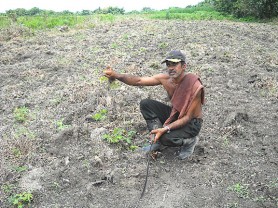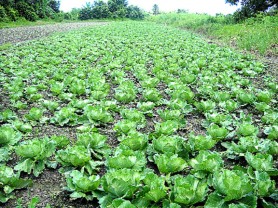(This is the second part in a series on the Grow More Food campaign. The first report appeared in yesterday’s Sunday Stabroek.)
In July of this year, Mahadeo Mohan decided to cut his losses and ploughed up his field of young cassava plants. He planted squash among the broken sticks and tubers in his Parika, East Bank Essequibo farm.

He had no choice, Mohan explained. At $5 per pound it made no sense to reap the crop much less leaving it to grow.
In Berbice, Worrell Lewis left 2000 boulanger plants alone, planning to cut them down. “The price ain’t right”, he explained. “$1000 can’t pay you”. In Black Bush Polder on the Corentyne, fields of ochro lay unpicked, the vegetable drying on the stalks. “Right now thing nah sell”, said Narinee Mangra, at her roadside stall. “Right now ochro ah $5 a pound and it nah pay foh pick”. Other farmers say the same thing. “This whole crop ahbe lose”, Mangra sighed.
Gluts
Growing production has resulted in gluts in the local market with farmers having no place else to turn to sell their produce. Export of fruits and vegetables is still to take off in a major way. Although farmers acknowledge that gluts are sometimes seasonal, some said they have responded to appeals to grow more but the markets have not materialized.
Agriculture Minister Robert Persaud says that production and exports have gone up significantly and the Ministry, through the New Guyana Marketing Corporation (GMC), aims to link farmers with buyers. He said in a recent interview with Stabroek News, that they are trying to encourage farmers before they plant, to do market surveys and assessments. “So rather than going and full up your field with a particular crop and hoping that the market will start; that is the new concept we want to introduce: where people secure markets and then work backward rather than working from the production and hoping by time you get the crop come in you have (a) market”, he said.

In 2006, Persaud initiated the Grow More Food campaign, aimed at keeping Guyana food secure and also to contribute to regional food security. Agriculture diversification and the support of farmers and those in the value chain were identified as critical pillars. Over the past two years, $3 Billion has been pumped annually into the sector and an additional $5.5B through the Agricultural Export Diversification Programme (ADP) and the Rural Enterprise and Agricultural Development (READ) Project will be ploughed into the industry over the next six years, Persaud said. He stressed that this is in addition to what government is spending. The investments by government have served to upgrade or build new infrastructure and provide services to farmers.
But in the almost four years since the Grow More Food campaign began and a number of initiatives started, many farmers- identifying markets as very critical to them, said that they have seen little change in this regard. They still battle the gluts in the local market and sometimes prefer to leave the crops to rot in the fields. The prices offered by the middle-men who buy from them are too low to make it worthwhile.
Mohan said he ploughed up a field of nine-month old cassava in July because of the low prices being offered. The local market always fluctuates, he said.
“We have identified new markets”, Persaud said when it was pointed out that since the Grow More Food campaign started, production would have been expected to increase and consequently there would have been a need for new markets. He said that when the campaign began, Guyana could have only exported six items to Trinidad but now this has expanded to 21 agricultural products. He said a market in the Dominican Republic did not exist but does now and in the US and Canada, activities are greater. He said Venezuela is a potential market and there are some countries where bilateral arrangements are being arranged. He said he recently met with Surinamese who want to get into the fresh fruits and vegetables and livestock business as well. But this will take time to build, he said.
Working backwards
The framework through which exports are expected to be ramped up is the ADP. “The ADP is export driven. The ADP is not just about producing; it is about market identification and then working backwards into the chain”, Persaud explained. He admits that the programme is now getting off the ground and it will be a while before exports are seen. “The results from the investments in the ADP, you wouldn’t see them next year, you won’t see them the year after. Many of the institutional, many of the big investments that we are making are for the long term. It’s for the vision”, he said. “So there is no early harvest in terms of all the deliverables of the ADP”. As an example, he said, in the building of an animal and plant health system, the results will not be seen immediately.
“But already we trying to link those activities which can see quick movement because there is already the demand, farmers are out there, more investors are coming in and so forth. So the ADP is a very strategic programme but in the meantime we are getting activities and it will cater for immediate and early take-off”, Persaud added.
But for many “cash crop farmers” across the main agricultural belt, in Ruby, Parika Backdam and in Black Bush Polder, in a series of interviews with Stabroek News, they said they have seen no “early take-off” in exporting. Several had experiences with the New GMC which have made them reluctant to produce specific crops for export without firm commitments. On the other hand, many seem reluctant to aim for the higher standards demanded for the export market. Others, simply, have not been approached on producing for other markets.
In Black Bush Polder, Hemnarine, grows hot pepper and sells to a middleman, who exports it. He relates his experiences and recounts stories from other farmers about attempts to get into export markets. He said at times, officials of the New GMC contact them about a specific crop. “Them ah come to you, when you plant am, they nah come back…them a tell you, plant that, market available, but you nah hear back nothing”, he said. “You can’t get any confidence for them. Dem ah tell you to plant. When the crop deh, they nah show up”, he said, adding that sometimes when attempts are made to contact the officials on the phone, it is turned off.
“They need to be in contact with the New GMC”, said Persaud. He pointed to a service provided where a farmer can type in a number and crop name on a mobile phone and a message appears displaying the price of the crop in Guyana and overseas. “If you don’t speak to anyone, it can tell you what the prices are and you make that determination”, he said, adding that they are trying to do this as much as possible. Markets are very important, he said adding that it is recognized that there are seasonal gluts too. “That is why in Guyana we badly need a processing sector”, he said. “Not everything we produce we will have a ready and lavish market for fresh (produce)”.





